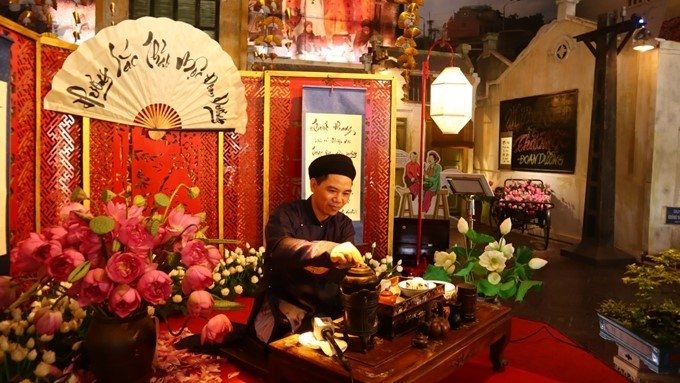
Tet Doan Ngo (traditional Double-Fifth Festival), which is observed in Vietnam and several Southeast Asian countries, is being reproduced at an exhibition held at the Thang Long Imperial Citadel in Hanoi.

An artisan practicing the art of enjoying royal tea.
The event, themed "The fragrance and beauty of medicinal herbs”, will feature exhibitions and reproductions of the folk and royal rituals and customs held during the traditional Double-Fifth Festival.
Visitors to the exhibition will learn about the practice of "killing pets and worms”, which is considered the most important ritual during the festival in Vietnam. People often eat fermented glutinous rice, fruits, pastries, with the belief of killing worms and becoming healthier.
In addition, visitors will get to know more about the role of herbal medicine in the life of Vietnamese people and the custom of plucking medicinal herbs prior to the Double-Fifth Festival.
They can also browse and purchase herbal products such as tea, altars and antiseptic water, which are healthy as well as environmentally friendly.
On weekends, visitors will have the chance to experience royal tea enjoyed with artisans Hoang Anh Suong, Nguyen Thien Hung and Nguyen Cao Son; as well as enjoy ca tru (ceremonial singing) performances by Meritorious Artist Bach Van.
Calligraphic works and imperial costumes will also be displayed at the event.
The exhibition is being held in online form via the address hoangthanhthanglong.vn and trungbayonline.hoangthanhthanglong.vn.
Source: NDO
With an increasingly vibrant and widespread emulation movement aimed at building cultured residential areas and cultured families, Yen Thuy District has been making steady progress toward improving both the material and spiritual well-being of its people, while fostering a civilized, prosperous, beautiful, and progressive community.
Once lacking recreational spaces and community facilities, Residential Group 2 in Quynh Lam Ward (Hoa Binh City) has recently received attention for the construction of a new, spacious, and fully equipped cultural house. The project followed the model of state support combined with public contributions in both labor and funding.
The "All people unite to build cultural life" movement, which has been effectively integrated with Kim Boi district’s socio-economic development goals, is fostering a lively spirit of emulation across local residential areas, hamlets, villages, public agencies, and enterprises. In addition, through the initiative, traditional cultural values are being preserved and promoted, while community solidarity and mutual support in poverty reduction and economic development are being strengthened.
A working delegation of the Hoa Binh provincial People’s Committee led by its Permanent Vice Chairman Nguyen Van Toan on June 11 inspected the progress of a project to build the Mo Muong Cultural Heritage Conservation Space linked to tourism services in Hop Phong commune, Cao Phong district.
Born and growing in the heroic land of Muong Dong, Dinh Thi Kieu Dung, a resident in Bo town of Kim Boi district, in her childhood was nurtured by the sweet lullabies of her grandmother and mother. These melodies deeply imprinted on her soul, becoming an inseparable part of her love for her ethnic group's culture. For over 20 years, this love for her hometown has driven Dung to research, collect, and pass down the cultural values of the Muong people to future generations.
In the final days of May, the Ethnic Art Troupe of Hoa Binh Province organized performances to serve the people in remote, mountainous, and particularly disadvantaged areas within the province. These were not just ordinary artistic shows, but they were the meaningful journeys aimed at spreading cultural values, enhancing the spiritual life of the people and contributing to the preservation of ethnic minority cultural identities.



